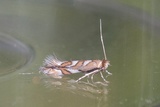Phyllonorycter muelleriella (Zeller, 1839) Species
Last modified: Dec. 14, 2024, 4:22 p.m.
A very local and rare species in Belgium.
Details
- Classification
- Family: Gracillariidae > Subfamily: Lithocolletinae > Genus: Phyllonorycter > Species: Phyllonorycter muelleriella
- Vernacular names
- Gevlekte eikenvouwmot (NL), Western midget (EN), Müllers Eichen-Faltenminiermotte (DE)
- Synonyms
- Phyllonorycter amyotella (Duponchel, 1840)
- First mention in Belgium
- De Fré Ch. 1858. Catalogue des Microlépidoptères de la Belgique. — Annales de la Société entomologique belge 2: 45–162. On page 155 (as amyotella). view page
- Status
-
Native
Distribution
Imago
Head brown; forewing ground colour golden brown; white pattern consisting of a quadrangular basal spot at dorsum, edged with dark brown scales; two costal and two dorsal striae, opposite to each other, the basal ones edged with brown scales on both sides, the proximal ones only at their basal side; a very small apical stria just before the apex; some white scales adjacent to a very dark brown horizontal line in the apical area. In the cilia a conspicuous brown-greyish hook.
Mine
A rather narrow, but long tentiform mine between two secondary veins, the base of the mine touches the main vein. Underside with one conspicuous, longitudinal fold in the middle.
See also gracillariidae.net and bladmineerders.be.
Cocoon/pupa
A cocoon attached both to the roof and the bottom of the mine; some frass is incorporated in the cocoon.
Bionomics
The species hibernates in the pupal stage. After emergence of the adult, the pupal skin protrudes from the mine.
Flight periods
Two generations a year in May and July–August.
Observed on
- Host plant (species):
- Quercus robur and Quercus petraea
- Host plant (genera):
- Quercus
The species lives preferably on Quercus, mainly Quercus robur and Q. petraea, but it has also been recorded on Q. pubescens and Q. cerris.
Habitat
The species seems to prefer a xerothermic environment, like the sandy soils of the Kempen (AN and LI).

